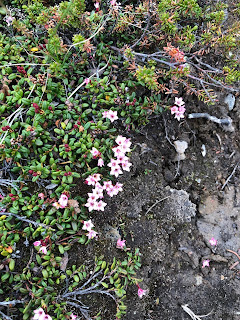I took Karen
up on her suggestion that I should sign up for the ‘challenging’ guided hike
(Eagle Point to Wickersham Dome). She took the middle road with the ‘moderate’
hike (McKinley Bar). Each hike covered about the same distance, the only
difference being the elevation changes. I’ve asked her to make a separate entry
to tell us about her hike.
Both our
groups left the lodge in the morning at the same time, each group having two
experienced guides as our leaders. On our way to the trailhead, we made a brief
stop again at Reflection Pond – still no Denali sighting, but better
reflection.
It was
overcast and in the mid-40’s with a slight breeze when we began our immediate
ascent through thickets of alder on a rocky and slick unmaintained trail. Even
though it was cool, the mosquitoes were lying in wait for us. As soon as we got
into the bushes, the feast began. Since we were bundled up with layers of
clothing, the only areas of bites were the eyelids, face, and ears. Ugh!
We made our
way quickly up the steep incline through the boreal forest (black spruce, white
spruce, alder, willow, and aspen), into what they call the tiaga (sporadic
stunted spruce trees, mixed with scrubby dwarf birch and various ferns, mosses,
and lichens), and finally above the tree line to the alpine tundra (moss,
lichen, and many varieties of wildflowers and other low-lying plants).
Our guides
told us the reason the trees and plants change in each of these zones, is due
to the thickness of the permafrost layer. As you move up in elevation, the
permafrost prevents plant and tree roots from growing too deeply. Ultimately,
at the alpine level, only the smallest and hardiest of plants can survive.
Some of the
plants we saw during the day were: Labrador Tea, Dwarf Dogwood, Bear Berry,
Blueberry, Cranberry, Sphagnum Moss, Wooly Lousewort (sounds like a good name
for a frontier gunslinger!), Alpine Azalea, Narcissus Anemone, Mountain Aven,
Lapland Rosebay, Caribou Lichen and Bell Heather, to name a few.
Just as we were
climbing toward the highest point on the ridge, we heard booms of thunder. The
wind began to blow and the rain came down. As a precaution, we waited just
below the ridge until we were sure the storm was moving away from us. Once the
rain passed us, we moved on up to the top of the ridge and stopped for lunch as
the sun came out. And, the mosquitoes were gone for a few hours!
Our hiking
guides, Marissa and Adderly had a nearly encyclopedic knowledge of the local
flora and fauna. They really helped make the day enjoyable. Since we are the
first group of tourists for the season, they were excited to show us all the
great features found in the National Park at this time of year.
After about
four hours, we turned around and headed back toward the lodge. Along the way,
we saw some wildlife: a rock ptarmigan, a small group of caribou, and other
curious creatures. We stopped at one spot to lay down on the tundra. It’s like
a very cushy bed, and it springs right back when you get up. Doing this shows
you how well the tundra insulates from above (to preserve the permafrost) and
from below (to keep any of us lounging animals warm).
I arrived
back at the lodge from our hike after spending about seven hours out on the
trail. Shortly after our return, the rain also returned. Now, Karen and I are
relaxing before tonight’s dinner.
Next: An
early morning bus ride back to civilization.












No comments:
Post a Comment